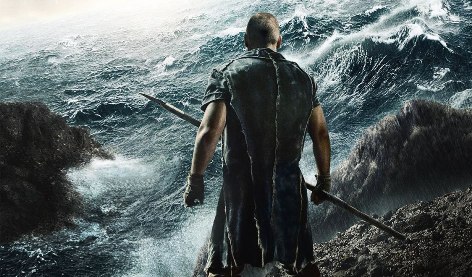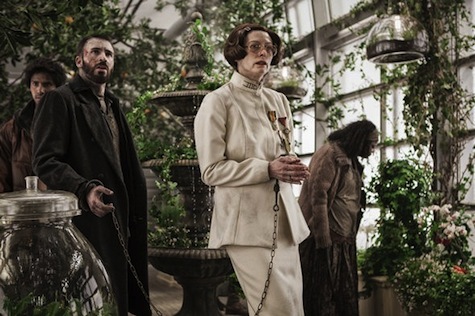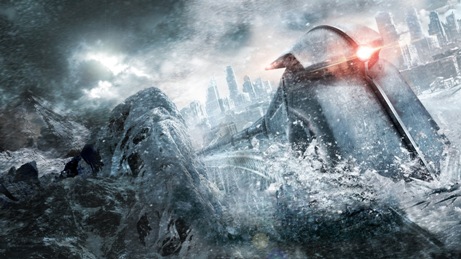It’s impossible to know who first told the story of a great flood that destroys most of the world, but the deluge myth appeared early and often in various cultures. The most famous account of the flood is, of course, the sketch of Noah’s Ark from Genesis, but the great deluge also figures prominently in the Mesopotamian epics of Gilgamesh and Atrahasis, in the Shatapatha Brahmana story of Manu, and in Ovid’s Metamorphoses. Variations abound, but the germ of the story is the same: the last vestiges of humanity huddle aboard a massive vessel while the rest of the world drowns.
In our eschatology-obsessed times, we’ve seen renewed interest in the deluge myth. This summer alone has given us two prominent variations in Darren Aronofsky’s Noah and Joon-ho Bong’s Snowpiercer. These two films present a natural and compelling contrast—while Noah portrays the deluge as religious retribution for wickedness, Snowpiercer presents it as a scientific calamity. In both cases, it would seem, humanity had it coming.
Aronofsky and his longtime co-writer Ari Hendel use the Genesis account of the flood as a jumping off place for a fantasy story that ups the End Times ante with fallen angels incased in rock and epic battles between tribes. These additions provoked the ire of people who consider the story of Noah to be sacrosanct—though since the story in Genesis is little more than a sketch of events, any dramatization would by necessity involve extrapolation. (The conventional wisdom that “the book is better than the movie” is never more true than for people who consider the book to be the unerring Word Of God. One wonders, then, what the point of a movie could possibly be. Another way to put it: the only reason to create a movie based on the story of Noah is to try to do something original with the story. Otherwise, just go read Genesis.)

Aronofsky’s Noah is very much in keeping with the obsessed protagonists of his earlier films, from Pi to Black Swan. Noah follows his religious visions to the end of the world, which Aronofsky renders in grand CGI scale. The screenwriters also do a fine job of teasing out disturbing elements of the deluge myth that rarely get much play. There’s a great scene of Noah sitting, cold and silent, among his animals in the dripping ark as his family begs him to let in some of the screaming people being dashed to death by waves outside their doors. (The haunting image of the final drowning souls desperately clinging to a rock evokes the biblical illustrations of the great Gustave Dore.) In the last third of this film, Noah becomes the de facto villain of the piece (though Aronofsky unwisely tucks evil Ray Winstone away in a storage compartment for no good reason other than to have a fistfight at the end). Convinced that the last vestiges of wicked humanity must die and that only the innocent animals must survive, Noah determines to murder the child of his pregnant daughter-in-law. This is pretty dark stuff, but it’s fitting because, for the first time, a filmmaker is exploring the underlying nihilism of a story in which virtually every man, woman, child, infant, animal, and plant on earth are washed away like an old stain. Noah is far from perfect, but it deserves points for being a summer blockbuster that actually seems interested in exploring the religious implications of an ancient story.
Joon-ho Bong’s Snowpiercer (which premiered in the director’s native South Korea about this time last year) approaches the deluge myth from a different angle. It tells the story of a world washed away in ice. When scientists attempt to combat climate change by releasing a chemical into the atmosphere, they inadvertently trigger a global freeze that destroys almost all of humanity. The only remaining people left are the passengers aboard a special train called the Snowpiercer. As the train travels the globe at a rate of one rotation a year, society forms along brutal class lines with the rich people in the luxurious front compartments and the poor people confined to a squalid existence in the back. One of the disenfranchised proletariat, Curtis (Chris Evans) leads a revolt. He and his team laboriously claw their way to the front compartment, doing battle against Mason (a gonzo Tilda Swinton) the chief operative of the train’s master, a mysterious figure named Wilford.

In keeping with the wild inventiveness of the talented Bong, the film is part dystopian sci-fi, part action flick, and part slow-boil horror movie. In its heart, though, it is pure deluge myth. As Curtis fights his way to the front of the train, each compartment springs some new surprise: a kindergarten class run by a chipper, gun-toting Alison Pill; a gentle English garden; a walk-through aquarium; an ass-bumping rave. It’s as if each compartment on this Ark houses a different cultural animal. By the time Curtis gets to the front, he’s seen every species in Wilford’s own personal zoo.
I won’t reveal the ending of Snowpiercer since the movie itself is constructed like a mystery. I didn’t know who the big star was going to be at the front of the train, and I’m glad I didn’t know. You could find this out with a simple IMDB search, of course, but why not let it be a surprise? Besides, what’s important is the way the story (written by Bong and Kelly Masterson, from the graphic novel Le Transperceneige by Jacques Lob, Benjamin Legrand, and Jean-Marc Rochette) smartly reconfigures the deluge myth as a climate change crisis compounded by a crisis of social inequality.
In a funny way, both Snowpiercer and Noah capture the weirdly innate optimism of deluge mythology. If all stories—even tales of death and ruin—contain some element of wish-fulfillment, then it’s easy to see why we’re still so attracted to this particular story. After all, we in the audience never assume we’re going to be one of the great multitude who drowns or freezes. We always picture ourselves as one of the lucky few who hop abroad the last boat—or train—just before the world ends.
Jake Hinkson is the author of the books Hell On Church Street, The Posthumous Man, and Saint Homicide. Read more about him at JakeHinkson.com. He also blogs at The Night Editor.










